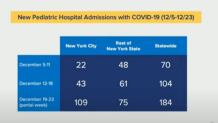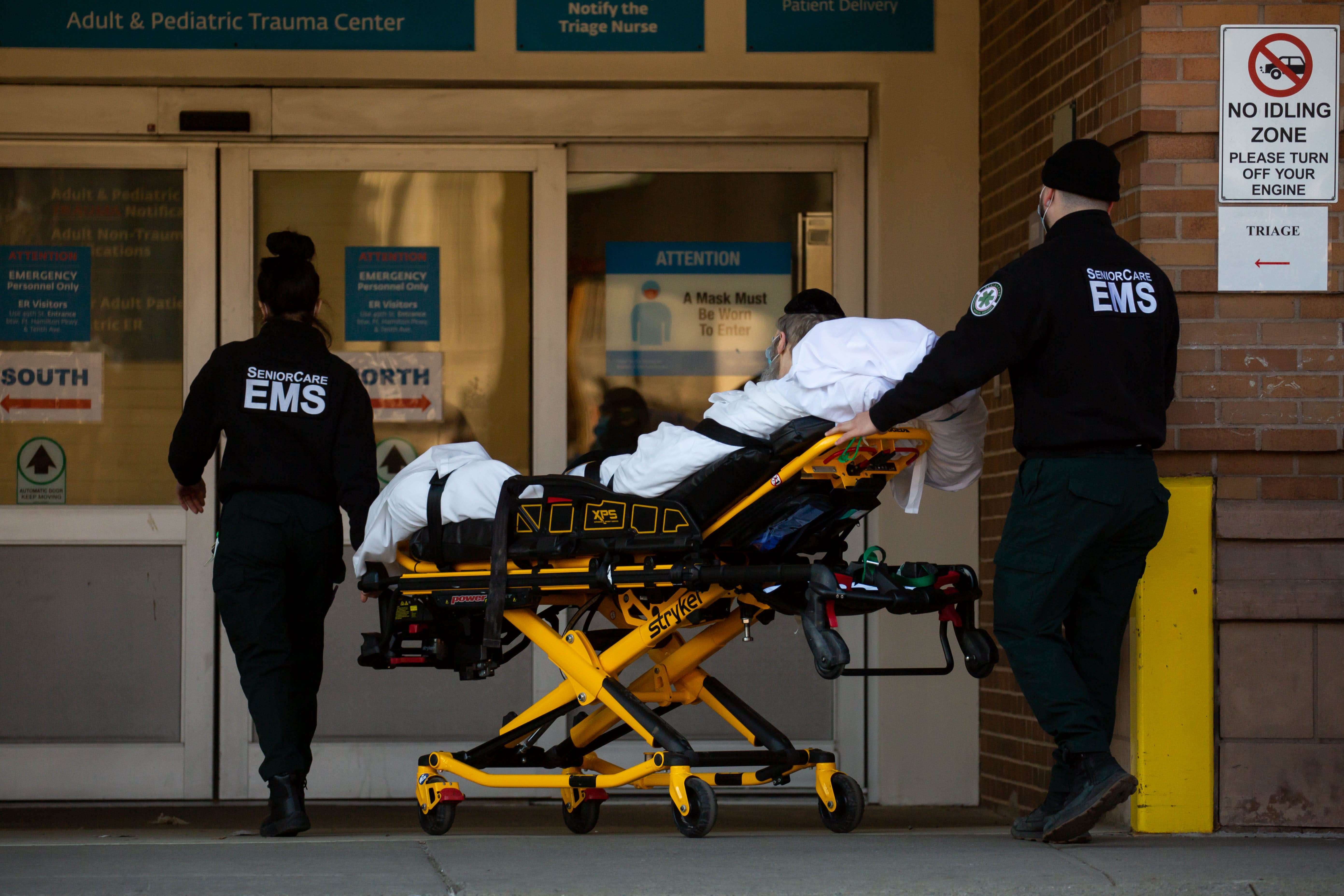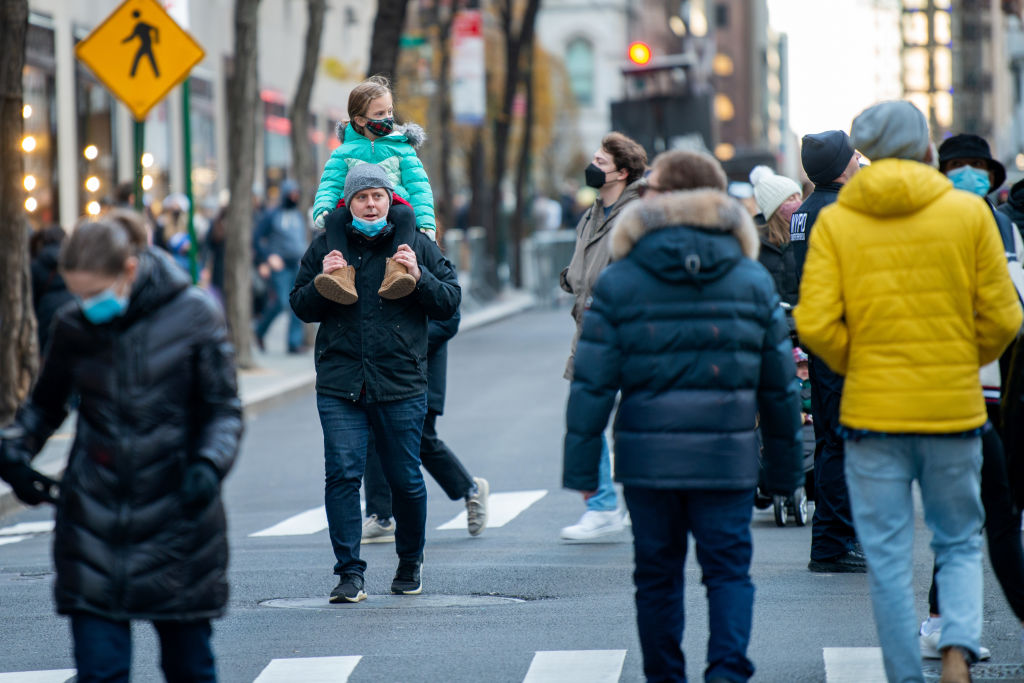What to Know
- Omicron is driving soaring rates in COVID infections and hospitalizations, especially among the vaccinated; admissions among NYC kids have quintupled in the last three weeks, officials say
- The combined threats of the variant, its link to higher yet more mild breakthrough infection rates, the holidays and lagging vaccination rates among young kids are driving new worries on schools
- Historically, NYC schools have been one of the lowest COVID transmission spots. Will that hold after the holidays? As of the latest data, there are 1,383 confirmed cases, 65% of them among students
New York City public schools will double their weekly PCR testing volume, test both vaccinated and unvaccinated students and open the option to staff as well in a bid to quell concerns over spiking COVID-19 hospitalizations among kids before they return to the classroom on Monday following a week-long holiday break.
Those are some of the immediate changes to better secure schools from this latest COVID wave, which Gov. Kathy Hochul said "is affecting children more than the past variants" as she briefly joined Mayor Bill de Blasio's COVID update on Tuesday.
"Before we always said, 'Don't worry so much.' That was a different variant," Hochul said. On schools, "We all have such a public interest. We saw the failed experiment, despite the very best efforts of incredibly hard-working, passionate teachers who did their very best with remote teaching and the parents who were just pulling their hair out at kitchen tables trying to make sure that it worked successfully."
The Democrat pledged to keep funneling state resources the city's way as needed, especially when it comes to tests. And de Blasio says the city intends to use them in tandem with federal supplies on a new approach he dubbed: "Stay safe, stay open."
Get Tri-state area news delivered to your inbox. Sign up for NBC New York's News Headlines newsletter.
Three key elements are expected to enhance the city's already "gold standard" approach to safely keeping schools open, de Blasio said:
- At-home testing kits will be distributed to a classroom if a student in the classroom tests positive
- All students in the affected classroom will report back to school the next day if they are asymptomatic and test negative
- Students will take two at-home tests over the course of seven days
"This guarantees more consistency in their education. It guarantees fewer disruptions. And it works because here's the fact we now know: 98% of close contacts don't turn into positive cases themselves," de Blasio said. "We have a lot of evidence now that tells us this is going to be the approach that works in the future."
According to the city, just 1 in 120 close contacts developed COVID-19 after an in-school exposure over the course of the 2021-22 school year. That so-called "secondary attack rate" stands at just 0.83%, and is far below the 15% secondary attack rate of 15% for close contacts within a household, the mayor says.
So what's changed? Omicron, officials say. New York schools were among the first in the country to implement vaccination mandates for Department of Education staff, 96% of whose employees are vaccinated as of Tuesday, de Blasio said.
But omicron's evidenced vaccine evasiveness has reinvigorated concerns about spread rates even in communities where they have been exceptionally low.
Still-too-low vaccination rates among elementary and middle school kids in the nation's largest public school district combined with a testing demand so intense that New Yorkers literally climbed over each other to snare free at-home tests during two citywide giveaways last week have only fueled those concerns.
COVID-19 at New York City Public Schools
This map shows all known cases of COVID-19 at New York City public schools. It is updated Sunday through Friday at 5:30 PM.
Building that has been closed
One or more classrooms has been closed
A member of the school community has tested positive but the school community was not exposed
Source: nyc.gov
As of the latest data, there are 1,383 confirmed positive COVID cases in NYC schools, 65% of them among students. Since schools reopened in person in September, students have accounted for 71% of the 26,274 confirmed infections.
Sixty-four public school classrooms were closed as of Dec. 27 (students' last day before holiday break was Dec. 23), while 1,011 classrooms were partially quarantined. Zero schools were closed completely because of outbreaks.
Even though the new variant is associated with milder symptoms than delta, those milder outcomes are highly contingent on vaccination -- and boosters. New York City has since COVID hospitalizations among kids quintuple in the last three weeks. Statewide, pediatric hospitalizations have doubled in the same time frame.
According to the state, none of the kids in the 5-to-11-year-old age group who have had to be hospitalized with COVID this month were vaccinated. That compares with about a quarter of older kids hospitalized in December, state officials say.

Both rates are significantly lower than their vaccination rates statewide (16.6% for those 5-11; 64.2% for those 12-17). An even smaller share of the youngest eligible group in New York City is fully vaccinated (15.7%), though the city's school pop-up vaccination sites are credited with helping fuel higher rates (70.8%) for kids 12-17.
Hochul, de Blasio and Mayor-elect Eric Adams have all urged parents to take advantage of the holiday break to get their children dosed if they haven't done so yet. To expedite the pace, New York City added kids aged 5 to 11 to its indoor vaccine mandate, but they only have to show proof of one vaccine dose. The mandate toughened Monday to require two for everyone aged 12 and older.
Adams is expected to keep at least that part of the vaccine mandate intact while his administration evaluates the private-sector component. Overall, de Blasio has described the mayor transition to Adams as "seamless" and expects Saturday's handoff will go smoothly with revised plans positioning schools to stay open.
The mayor-elect, who also made brief remarks during de Blasio's briefing, affirmed the seamless transfer thus far, which he says is critical in this vulnerable time. He also voiced support for the new testing plan.
"COVID is a formidable opponent, and it is organized on how it has affected and impacted our city," Adams said. "If we're not organized, if we're not together and unified, that will send the wrong message to New Yorkers. We spent $11 trillion fighting COVID. It's time for us to realize that this is a resilient city and a resilient country. We must reopen our city and we can do that."
“Two clear messages we're sending loud and clear,” said Adams, who joined de Blasio's virtual coronavirus briefing. “Your children are safer in school. The numbers speak for themselves. And we are united to make sure they continue to be safe.”
More Coverage
Officials hope the school adjustments, along with increased testing capacity for schools, will help mitigate the recent viral spikes. New York City schools already test children from first grade up on a randomized, weekly basis, though the number of kids tested in any given week is just a fraction of the student population. The city will double the number of random COVID-19 tests it conducts in schools and will include vaccinated as well as unvaccinated students, the mayor said.
"State and city working together, we're going to make sure there's no shortage of supply as well as making sure in the case we need ambulances, we just sent 10 more ambulances to New York City as well," Hochul said, vowing to continue a spirit of collaboration with the mayor that didn't exist with her predecessor.
The city's largest teacher's union, United Federation of Teachers, questioned whether the enhanced testing policies were sufficient.
"Teachers are prepared to do their jobs starting Jan. 3. The real issue is whether the city can do its job — ensuring that new testing initiatives are available in every school and an improved Situation Room is actually in place by next week," UFT President Michael Mulgrew said in a statement. "We are moving closer to a safe re-opening of school next week. But we are not there yet."
Mulgrew did thank Hochul for providing the 2 million home test kits “so that anyone with close contact with a positive case will be able to know immediately if they are infectious and must quarantine.”
Another 40 city-run test sites are scheduled to open this week, bringing the number of locations above 150. Capacity is only expected to ramp up over the next weeks.
Schools are one of the few places where masks remain universally required regardless of vaccination status. That at least seems like it will stay the norm for the foreseeable future, as will other enhanced school safety protocols like deep cleans, weekly testing, social distancing and outdoor learning as appropriate.
Omicron has fueled unprecedented daily infections across the U.S. and New York, which shattered its own single-day record at least eight times in the last 11 days.
The variant, the first local case of which was reported on Dec. 2, accounted for 73.3% of genetically sequenced positive New York COVID samples uploaded to GISAID, the world's largest repository of COVID-19 sequences, over the last two weeks. That's up from about 66% a day ago, 11.1% in the two-week period ending Dec. 18 and from 2.2% in the two-week period before that, state data shows.
CDC data for the latest two weeks says omicron could account for anywhere from 70% to 97% of current infections in the New York area for the week ending Dec. 25. Nationally, the prevalence is estimated to be as high as 74%, the agency says.



